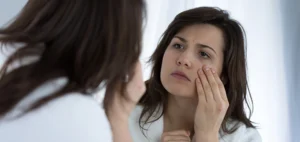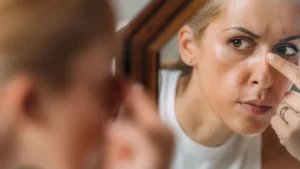Struggling with how you see yourself in the mirror, obsessing over flaws that seem invisible to everyone else? You’re not alone. This feeling, where your reflection seems to tell a harsh story, could be a sign of Body Dysmorphic Disorder (BDD). But here’s the hopeful part: you can find ways to feel better and see yourself in a new light. In this blog, we’re going to unpack BDD – from what it really means to recognizing its subtle signs. Most importantly, we’ll explore effective treatments that can make a big difference. Ready to start seeing yourself in a kinder light? Let’s dive in.
Contents
What is Body Dysmorphic Disorder (BDD)
 Body Dysmorphic Disorder (BDD) is more than just worrying about how you look. It’s a mental health condition where you can’t stop thinking about one or more perceived defects or flaws in your appearance — flaws that are either minor or not observable to others. But in your mind, these flaws are significant and often cause severe emotional distress and problems in daily life.
Body Dysmorphic Disorder (BDD) is more than just worrying about how you look. It’s a mental health condition where you can’t stop thinking about one or more perceived defects or flaws in your appearance — flaws that are either minor or not observable to others. But in your mind, these flaws are significant and often cause severe emotional distress and problems in daily life.
Interestingly, BDD is closely related to Obsessive-Compulsive Disorder (OCD), as both disorders involve intrusive, persistent thoughts and repetitive behaviors aimed at reducing anxiety.
For example, just as someone with OCD might repeatedly check that the doors are locked to alleviate fears of burglary, a person with BDD might continually check their appearance in the mirror or seek reassurance from others to lessen their distress over how they look.
- People with BDD might spend hours checking themselves in the mirror, grooming excessively, or engaging in other behaviors to fix or hide the perceived flaw.
- They might also seek out numerous cosmetic procedures with little satisfaction.
But here’s the key difference between BDD and typical appearance concerns: the intensity of the worry and the time spent worrying about it. For someone with BDD, these concerns are persistent, often consuming many hours a day and significantly interfering with their daily activities, social life, and work.
BDD goes beyond the normal self-consciousness or dissatisfaction with one’s appearance that many people experience. It’s an obsession that can lead to significant anxiety, depression, and even thoughts of suicide.
What is the Root Cause of BDD?
 The root cause of Body Dysmorphic Disorder (BDD) is not fully understood and is likely multifaceted, involving a combination of genetic, neurobiological, environmental, and psychological factors. However, here are some psychological factors associated with BDD:
The root cause of Body Dysmorphic Disorder (BDD) is not fully understood and is likely multifaceted, involving a combination of genetic, neurobiological, environmental, and psychological factors. However, here are some psychological factors associated with BDD:
- Low Self-Esteem: Persistent negative beliefs about one’s self-worth and abilities can contribute to the development of BDD, as individuals may focus on their appearance as a way to compensate for these feelings.
- Abuse or Bullying: Experiences of abuse, whether physical, sexual, or emotional, particularly those related to appearance, can lead to BDD. Bullying, especially during the vulnerable years of childhood and adolescence, can leave lasting impacts on how individuals perceive themselves.
- Perfectionism: A tendency towards perfectionism, or the need to be or appear perfect, can drive the obsessive thoughts and behaviors characteristic of BDD.
- Social Comparison: Constant comparison of oneself to others, particularly in today’s social media-driven society, can exacerbate feelings of inadequacy and dissatisfaction with one’s appearance.
- Traumatic Events: Experiencing traumatic events, especially those that leave visible scars or changes in appearance, can trigger or worsen BDD symptoms.
- Family Dynamics: Growing up in a family that places a high value on appearance or where criticism of appearance was common can increase the risk of developing BDD.
Understanding these psychological factors is crucial in identifying BDD and underscores the importance of addressing these underlying issues in treatment to effectively manage and overcome the disorder.
Treatment to Manage Symptoms of BDD
Cognitive Behavioral Therapy (CBT) for BDD
 Cognitive Behavioral Therapy (CBT) stands out as a highly effective treatment for managing the symptoms of Body Dysmorphic Disorder (BDD).
Cognitive Behavioral Therapy (CBT) stands out as a highly effective treatment for managing the symptoms of Body Dysmorphic Disorder (BDD).
- Identifying Distorted Thoughts: CBT helps individuals recognize the specific thoughts and beliefs about their appearance that are unrealistic or unhelpful. This could include beliefs that they are unattractive or that others are constantly judging them based on their perceived flaws.
- Challenging Negative Thoughts: Once these thoughts are identified, the therapist works with the individual to challenge and question their validity. This might involve examining the evidence for and against these beliefs or considering alternative, more balanced ways of thinking about their appearance.
- Changing Behaviors: CBT also focuses on changing the behaviors associated with BDD, such as excessive checking in mirrors, skin picking, or seeking reassurance. The therapist might use exposure therapy, gradually encouraging individuals to face situations they’ve been avoiding due to their appearance concerns, without resorting to their usual coping mechanisms.
- Developing Coping Strategies: Individuals learn healthy coping strategies to manage the distress and anxiety that appearance concerns can cause. This might include relaxation techniques, mindfulness, or activities that boost self-esteem and body image.
The goals of CBT in treating BDD are to reduce the obsessive thoughts about appearance, decrease the compulsive behaviors, and ultimately improve the individual’s quality of life. By focusing on both thought and behavior patterns, CBT provides a comprehensive approach to managing BDD, offering hope and a path toward recovery for those struggling with this challenging disorder.
Medication Options for Managing BDD Symptoms
 Alongside cognitive behavioral therapy, medication is another crucial component in the treatment plan for managing symptoms of Body Dysmorphic Disorder (BDD). The most commonly prescribed medications for BDD are Selective Serotonin Reuptake Inhibitors (SSRIs). Here’s how they work and what symptoms they target:
Alongside cognitive behavioral therapy, medication is another crucial component in the treatment plan for managing symptoms of Body Dysmorphic Disorder (BDD). The most commonly prescribed medications for BDD are Selective Serotonin Reuptake Inhibitors (SSRIs). Here’s how they work and what symptoms they target:
- SSRIs are a type of antidepressant that can be effective in reducing the obsessive thoughts and compulsive behaviors associated with BDD.
- They work by increasing the levels of serotonin, a neurotransmitter in the brain that affects mood, thereby helping to alleviate anxiety and depression symptoms that often accompany BDD.
How They Work:
- SSRIs help to balance serotonin levels in the brain, which can improve mood and reduce feelings of distress
- These are particularly helpful in targeting the obsessive and compulsive aspects of BDD, including constant checking, grooming, or seeking reassurance about appearance. They can also help reduce the anxiety and depression that people with BDD frequently experience.
It’s important to note that medication works best as part of a comprehensive treatment plan to overcome BDD that includes therapy. Starting any medication should always be under the guidance of a healthcare professional who can monitor its effectiveness and manage any side effects.

 Here are certain lifestyle changes and coping strategies that can significantly help manage symptoms on a day-to-day basis.
Here are certain lifestyle changes and coping strategies that can significantly help manage symptoms on a day-to-day basis.
